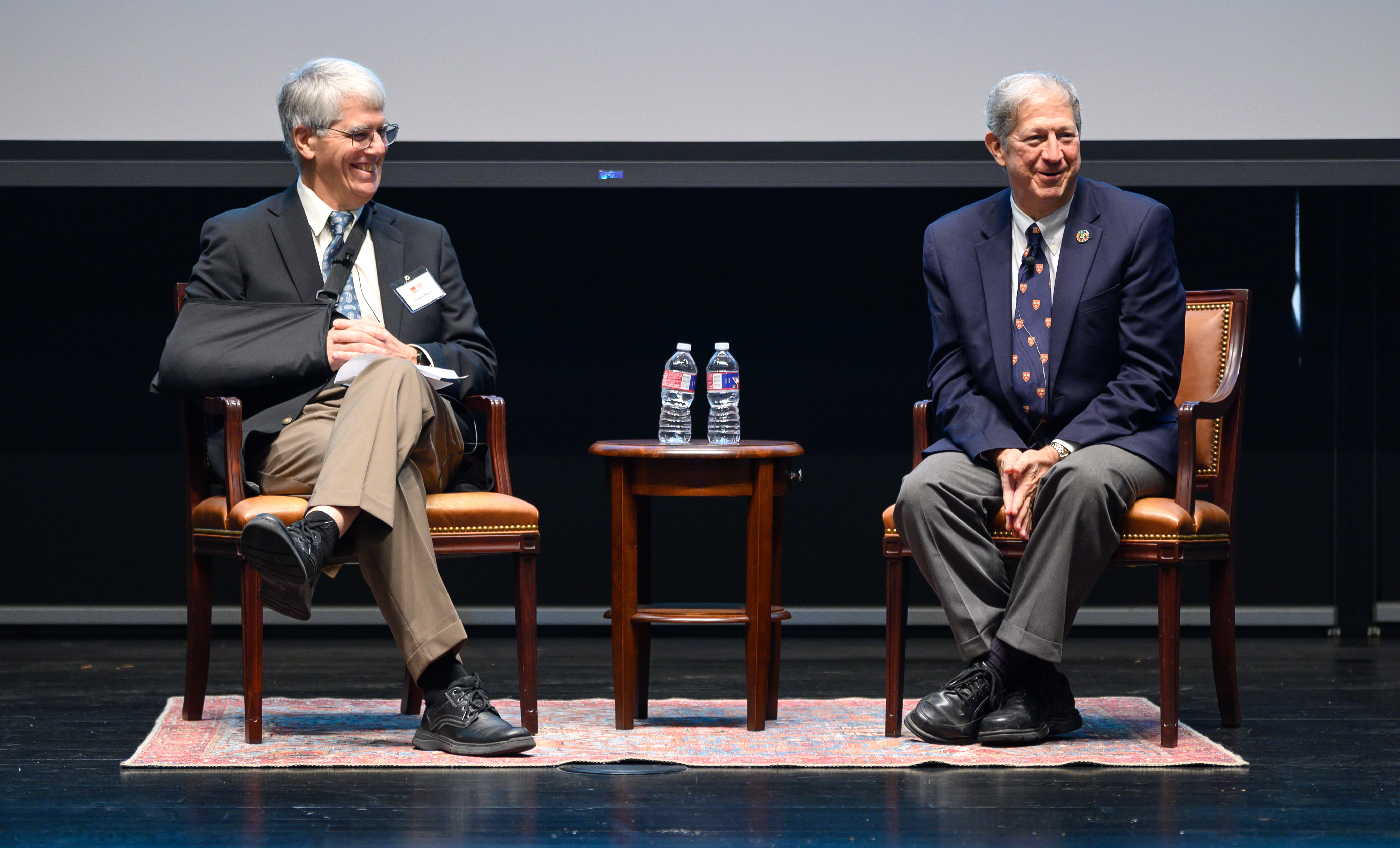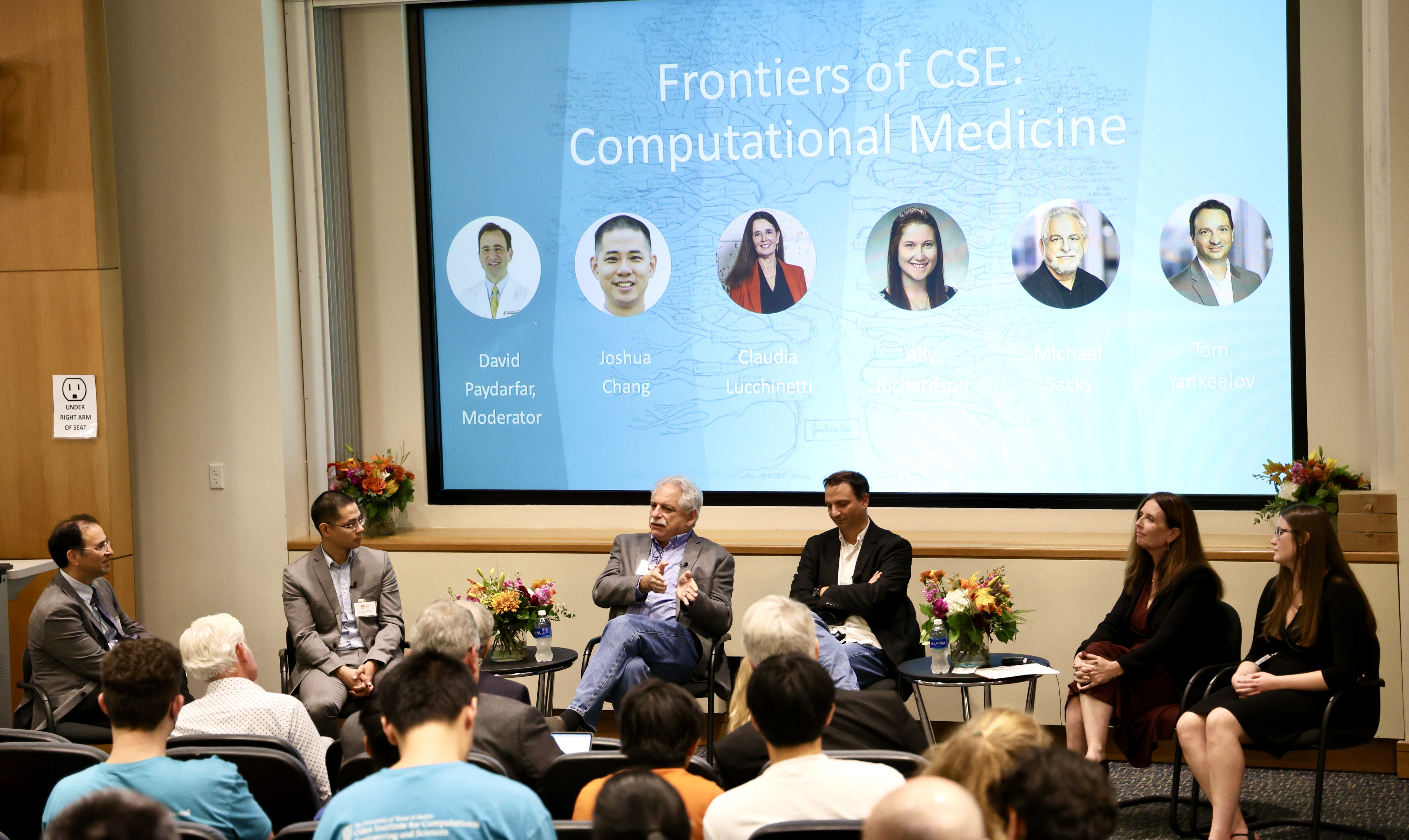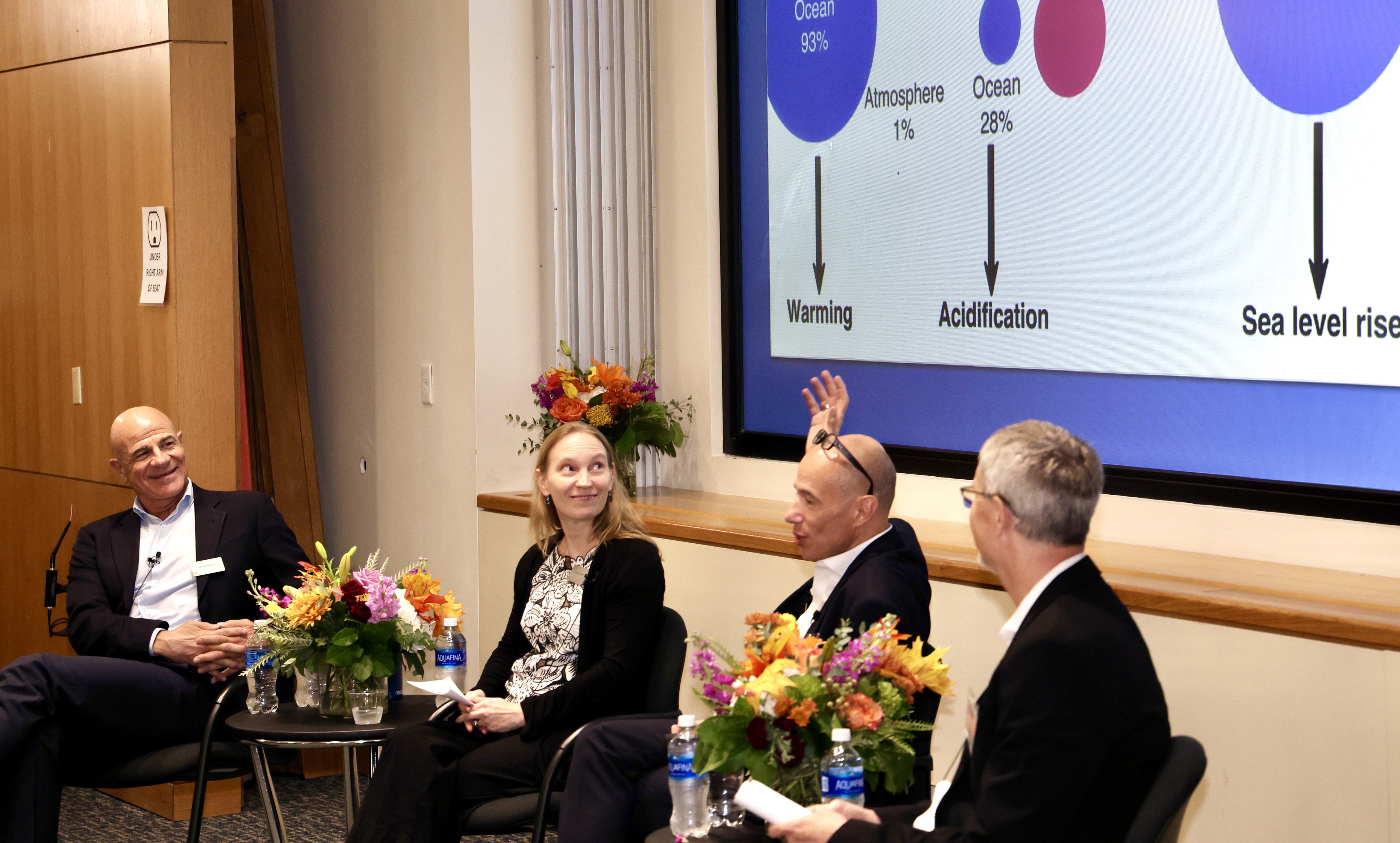University of Texas at Austin: Oden Institute Marks Half a Century of Interdisciplinary Leadership
The Oden Institute for Computational Engineering and Sciences at The University of Texas at Austin celebrated its 50th anniversary on September 21, hosting a full day of events, which featured two keynote addresses and afternoon panels looking at the future of computational science and engineering (CSE).
Opening remarks from university provost Sharon Wood kicked off the morning from Mulva Conference Center and Auditorium at the Engineering Education and Research Center. “I am honored to be here with all of you as we celebrate the anniversary of the Oden Institute, which has been a true center of excellence and impact on our campus for 50 years. Or as President Hartzell called it this week in the Faculty Council meeting — one of the “crown jewels” of UT!”
Director of the Oden Institute Karen Willcox gave a condensed history of the Institute. “Our founder, J. Tinsley Oden, had remarkable vision, and while most people would have been satisfied at any one of the remarkable stages of the Institute’s growth, Tinsley pushed for more, every step fraught with barriers, to build this unique interdisciplinary place. He would always say it’s about the people, and building an environment that attracts the very best in their respective fields.”
“Because we have this incredible building, built and given to us by Peter O’Donnell, students, researchers, and faculty can walk down the corridor, and bump into a mathematician or an engineer, have lunch with one another and discuss their research. These are the conversations where new ideas are born. These are the seeds that Tinsley planted half a century ago,” Willcox said. Oden, who died less than a month before the celebration, was lauded throughout the day for his vision, perseverance and foresight in building an interdisciplinary institute.
Attendees received bluebonnet seed packets with their event materials, which gave nod to the annual spring Institute retreat Oden held at his family ranch in the hill country during wildflower season. Willcox invited guests to metaphorically plant a little bit of Oden wherever they go.

Robert Moser (l) leads a fireside chat following David Keyes’s (r), keynote. Credit: Brian Bizer
The first of two keynote addresses was given by David Keyes, professor of applied mathematics, computer science and mechanical engineering and Senior Associate to the President at King Abdullah University of Science and Technology (KAUST). “We are the living legacy of what Tinsley began,” said Keyes, who previously served on the Oden Institute Board of Visitors.
His keynote, “From Accuracy to Efficiency: Leveraging an Oden Legacy,” focused on the field of high-performance computing (HPC) and energy efficiency. “As computational infrastructure demands a growing sector of research budgets and global energy expenditure, we must enhance utilization efficiency…we must address the energy elephant. Frontier, which is the top HPC system, delivers about 1 Exaflop/s at about 50 Gigaflop/s per Watt,” explained Keyes. That power usage can cost up to $40 million in annual electricity, the carbon footprint equivalent to 20,000 typical passenger cars in the USA. Keyes pointed out that a 10X improvement saves $36 million/year, is which equivalent to removing 18,000 cars from the road.
The second keynote, given by Douglas Kothe, “Dawn of the Exascale Computing Era,” expanded on topics introduced in Keyes’s address, including the top HPC system, Frontier, and energy efficiency. Frontier, which debuted in May 2022 at Oak Ridge National Laboratory (ORNL), is the world’s fastest supercomputer and the world’s first supercomputer to break the performance barrier known as Exascale. Frontier can do more than 1 quintillion calculations per second.
Kothe is currently the Associate Laboratories Director for Advanced Science and Technology and Chief Research Officer at Sandia National Laboratories. He showcased how Frontier is enabling scientists to tackle many projects that could vastly improve the understanding of critical processes, from drug delivery to nuclear fusion reactors to modeling potential cancer cures.
I am honored to be here with all of you as we celebrate the anniversary of the Oden Institute, which has been a true center of excellence and impact on our campus for 50 years.
— Sharon L. Wood, UT Provost
Three panel discussions looking at the future of CSE took place at Avaya Auditorium in the Peter O’Donnell Building. Discussions were engaging and covered topics as wide-ranging as the future role of artificial intelligence (AI) in CSE and making the impact of research accessible and understandable to the general population.
The first panel, Frontiers of CSE: Methods and Algorithms, was moderated by Per-Gunnar Martinsson, a professor of mathematics and Moncrief chaired professor at the Oden Institute. Panel members included UT faculty members George Biros, Alex Dimakis and Bjorn Engquist, along with Beatrice Riviere, an alumna of the Computational Science, Engineering and Mathematics (CSEM) graduate program and current faculty member at Rice University.
Panelists described their research in the methods and algorithms that underpin the great impact CSE has on society. The discussions covered advances in computing, machine learning, discretization methods and scalable algorithms, with the critical role of linear algebra being a crosscutting theme. They also discussed the teaching and training of students, and the importance of coursework in topics such as finite element methods and linear algebra, to prepare students for graduate programs.
“CSE Frontiers: Computational Medicine,” the second panel, was moderated by David Paydarfar, department chair of Neurology at Dell Medical School. Panelists discussed the use of AI, enabled by data collected through wearable devices such as smartwatches. Panelists emphasized the importance of incorporating the data into usable information for patients, as well a need for strong connections between computational medicine research and clinical usability. The interactive session was made up of a panel of physicians, Oden Institute faculty members Michael Sacks, and Tom Yankeelov, and a CSEM graduate student Ally Richardson, who provided different viewpoints about the utility of computation in medicine from the physician and researcher points-of-view.
“The environment to translate and apply this computing knowledge is going to combine everyone – the engineer, the clinician, the scientist, and the mathematician – and all must be traveling in a synchronized environment in the lifecycle,”said panelist Claudia Lucchinetti, Dean of Dell Medical School.
Joshua Chang, M.D., and Ph.D, and an assistant professor at Dell Medical School, brought his unique perspective to the panel, having bridged both bench and bedside perspectives. “Synergistically we need to use these perspectives together.” Chang highlighted the opportunities in bringing forth more quantitative approaches, which he explained are not emphasized in medical school training.
Panel members discuss the future of computational medicine. Credit: Joanne Foote
Looking to the future, all the panelists agreed that it is about training the right people. Michael Sacks, a professor of biomedical engineering and Director of the Willerson Center for Cardiovascular Modeling and Simulation at the Oden Institute questioned what steps can be taken to educate students with the right breadth of computational medicine and clinical medicine to come up with the best solutions for patients.
“I think the key is to offer the right coursework, and getting Ph.D students in the same environment as clinicians – whatever models are developed – we need to have an understanding of how clinicians can implement them,” said Ally Richardson, a fourth year Ph.D student in CSEM. She says the Oden Institute is well situated to take the lead, with the new Computational Medicine Portfolio program offered since Fall 2022.
“CSE Frontiers: Impacts Across Science and Engineering,” was the final panel discussion, chaired by Omar Ghattas, a professor of mechanical engineering and Director of the OPTIMUS Center at the Oden Institute. Panel discussions envisioned the role that CSE can play in areas of climate modeling, coastal modeling, and astrophysics, and the future of those fields. Panelists lauded UT’s world-leading computing facilities, including the Texas Advanced Computing Center (TACC).
Panelist Stella Offner, associate professor of astronomy and core faculty at the Oden Institute, said the availability of TACC is one of the reasons she came to UT and pointed to the critical role of the Oden Institute as an interdisciplinary hub. “The Oden Institute is a nexus point of intellectual activity where I can collaborate with others.” Offner outlined research frontiers in astrophysics and jokingly noted that, though this has been said before, astronomy has truly entered the era of big data.
The Oden Institute is a nexus point of intellectual activity where I can collaborate with others.
— Stella Offner, associate professor of astronomy
Stella Offner, associate professor of astronomy
As echoed in earlier panels, Clint Dawson, a professor of aerospace engineering and engineering mechanics and lead of the Computational Hydraulics Group at the Oden Institute, reiterated the importance of communicating research impact to a wider audience. Dawson’s current work focuses on coastal storm surge modeling. “No one has resources like we do at UT,” said Dawson. “In my corner of research, there’s been a data explosion in the last 20 years – and there are pluses and minuses with all the data. I work in real time mode and understand things from past and predict what might happen in the future. Forecasting is tough – and working with NOAA, the Army Corps of Engineers – they have operational needs, but also need to satisfy their stakeholders and be good stewards of the information they provide to the public.”
Patrick Heimbach, professor with the Department of Earth and Planetary Sciences and lead of the Computational Research in Ice and Ocean Systems Group (CRIOS) at the Oden Institute, emphasized the power of computer models in understanding and managing climate change. He noted the difficulty and expense in observing the interior of the ocean, pointing out the importance in bringing observational data and physical models together to gain the most understanding. He highlighted the challenge of “optimal experimental design” – where and how to physically deploy sensors in the ocean – as one area where this combination of data and models can drive better decision making.
Following a full day of thought-provoking ideas and imagining the future – from carbon footprints to embracing the AI revolution in the future of CSE, the celebration concluded with a reception and poster session representing work from the Oden Institute’s 25 centers and groups.
“It was interesting to see the variety of presentations throughout the day and how it all came together,” said Casey Stowers, a fourth year CSEM student who works with the Center for Computational Oncology. “I started school during COVID, and this helps me feel more connected.”

A reception and poster session was held in the Peter O’Donnell, Jr. Building. Credit: Joanne Foote
Alumnus Peng Chen, who is now an assistant professor at Georgia Tech in the School of Computational Science and Engineering, was excited to be back for the events. “Since I was at the Oden Institute for many years and only left about a year ago, it felt like coming back home. The anniversary celebration was an excellent event to meet and talk to friends. I especially enjoyed the three panels and it was great to learn the legacy and vision of Oden Institute on the current challenges, opportunities, and future directions in the next decade.” Chen was a researcher with the OPTIMUS Center under Omar Ghattas and said his time at the Institute had tremendous impacts on shaping his research interests and career.
James Chelikowsky, professor of physics and Director of the Center for Computational Materials at the Oden Institute, echoed what many other attendees expressed. “It’s a shame Tinsley wasn’t here to see this. So much of this is his story. It’s provided me with new perspective of what he had to endure to bring the Institute to where it is today.”
In her opening remarks the provost stated the Institute is a prime example of just how impactful, influential, and exceptional the entire UT research enterprise is. “The Oden Institute is contributing to our university’s academic mission in truly profound ways,” said Wood. “There is a fundamental understanding that in order to conduct groundbreaking research and change the world, you often need to build strong cross-disciplinary partnerships. The Institute draws faculty from 24 different UT departments across five different colleges and schools … and it’s emblematic of the collaborative culture that truly sets UT apart. Time and again, the Oden Institute has been a model for how research units build and grow those critical partnerships. My sincere thanks and congratulations to all the past, present, and future collaborators who continue to position the Oden Institute as a world leader.”



